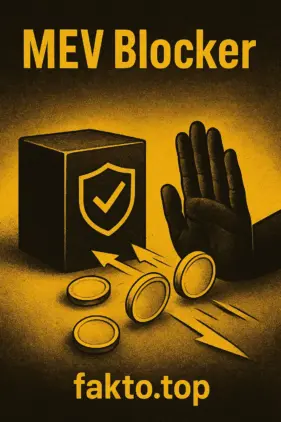MEV Blocker – Protect Ethereum Transactions from MEV Risks
MEV Blocker: The Ultimate Guide to MEV Protection and Avoiding Sandwich Attacks Crypto
In the dynamic world of Ethereum trading, safeguarding your transactions is critical to avoid losses from bots and opportunistic traders. Using MEV Blocker provides a powerful shield against the challenges of Maximal Extractable Value (MEV) and effectively protects your trades from common pitfalls like frontrunning and sandwich attacks crypto.

This MEV Blocker solution operates by routing private transactions through specialized channels in the Ethereum mempool, making them invisible to Searchers and Builders attempting Backrunning.
By integrating with advanced DeFi security protocols, the MEV Blocker framework ensures that priority fee settings are optimized and slippage tolerance is maintained even during high network congestion.
With features like Proposer-Builder Separation (PBS), Agnostic Relay, and Beaver Build coordination, MEV Blocker not only protects assets but also improves efficiency, offering Gas fee refunds when possible.
Overall, this MEV Blocker tool transforms the chaotic blockchain ecosystem into a controlled and predictable environment, giving traders confidence in their Ethereum transactions.
1. Anatomy of the Threat: Why You Need MEV Protection
The need for robust MEV protection stems from the inherent transparency of the Ethereum mempool, often called the “waiting room” for unconfirmed Ethereum transactions. When you submit a trade, it sits in this public pool, where automated Ethereum MEV bots—or Searchers—scan the data for profitable manipulation opportunities.
Understanding the Mechanisms of MEV Exploitation
Maximal Extractable Value is fundamentally the value that can be extracted by block validators or searchers by including, excluding, or reordering transactions within a block. While some forms of MEV are considered “neutral” (like simple arbitrage), others are directly toxic to the end user.
The most damaging and prevalent forms of toxic MEV
- Frontrunning: This occurs when a bot detects your favorable trade in the Ethereum mempool and executes a similar trade before yours by paying a higher Priority fee. This moves the price against you, forcing your transaction to execute at a worse rate.
- Backrunning: This is the act of placing a transaction immediately after a target transaction to capture the price impact created by the first trade. In a typical sandwich attack, Backrunning is the final step used to exit the trade and secure profit.
- Sandwich attacks crypto: A bot identifies your large pending trade, executes a small buy order (Frontrunning), your large trade executes at the artificially higher price, and then the bot executes a sell order (Backrunning), capturing the difference. These attacks are essentially an invisible tax draining billions from everyday DeFi users.
If you are wondering how to avoid MEV losses, understanding these attack vectors is the first and most critical step. Effective MEV protection must ensure that your trade’s intent remains confidential until execution.

2. How MEV Blocker Works: The Technical Deep Dive
Many traders wonder How MEV Blocker works in real-world Ethereum conditions. The core principle of MEV Blocker is simple: it hides your order from the public eye and places it directly in front of the Builder—the entity responsible for creating the block—thereby bypassing malicious Searchers.
The Role of Private Transactions and RPC Endpoints
Instead of sending your transaction to the public Ethereum mempool, MEV Blocker utilizes a dedicated, highly secure RPC endpoint MEV. When you connect your wallet (like MetaMask) to this endpoint:
- Private Routing: Your transaction becomes a private transaction and is sent only to a trusted set of Builders through a secure channel like the Agnostic Relay.
- Searcher Blindness: Since the transaction never enters the public Ethereum mempool, the Ethereum MEV bots or Searchers cannot detect, frontrun, or initiate a sandwich attack crypto against it.
- Optimal Execution: The transaction bundle is sent directly to the Block validator via the Proposer-Builder Separation (PBS) framework. This ensures that the transaction is only included if it won’t revert and is placed at the most favorable position possible.
Utilizing Advanced Infrastructure Components
| Component | Function within MEV Blocker | Key Benefit for the User |
|---|---|---|
| Agnostic Relay | Centralized network component facilitating private communication between users and Builders. | Ensures private transactions bypass the public mempool reliably. |
| Beaver Build | Primary Builder in the network, specialized in blocks prioritizing user protection and efficient execution. | Guarantees inclusion in a block built with MEV protection as a priority. |
| Proposer-Builder Separation (PBS) | Separates block creation (Builder) from finalization (Validator). | Prevents the Block validator from stealing MEV; Builder handles optimal transaction ordering. |
By utilizing this infrastructure, MEV Blocker is able to protect transactions from sandwich attacks and ensure optimal slippage tolerance is achieved.
3. Implementation and Financial Value Proposition
For anyone asking MEV Blocker what it is and how to use, the process is straightforward, and the financial benefits—especially MEV Blocker refunds fees—are substantial.
How to Add MEV Blocker to MetaMask
The simplest way to start your MEV protection journey is by connecting your wallet to the service’s private RPC endpoint MEV.
- Open MetaMask: Go to the MetaMask wallet interface.
- Network Selection: Click the network selector at the top (usually “Ethereum Mainnet”).
- Add Network: Select “Custom RPC” or “Add Network” > “Custom.”
- Enter RPC Details: Input the network name (e.g., “MEV Blocker RPC”) and paste the official RPC URL provided by the service. This URL is your new secure gateway.
- Save: Once saved, select this new network. All subsequent transactions will now be routed as private transactions, effectively setting up your MEV protection.
Choosing the best RPC for MEV protection means selecting a service that is free, fast, and transparent about Backrunning strategies and refund policies. The MEV Blocker RPC endpoint MEV is highly recommended for its security track record and financial incentives.
The Financial Advantage: MEV Blocker Refunds Fees
A unique feature that helps protect transactions from sandwich attacks is the refund mechanism. When a trade routed through MEV Blocker creates neutral MEV, the profits captured by the Searchers (now working for the MEV Blocker pool) are distributed.
MEV Blocker refunds fees by sharing up to 90% of this extracted value back to the user, minus a small commission for the Block validator and relay infrastructure. This turns the Ethereum hidden tax into a user rebate, making transactions more cost-effective and maximizing capital efficiency.
Conclusion
MEV Blocker is a critical, advanced tool for securing Ethereum transactions in the modern blockchain ecosystem. By mastering MEV Blocker what it is and how to use, traders can leverage private transactions, Proposer-Builder Separation (PBS), Agnostic Relay, Beaver Build, and DeFi security protocols to maintain predictable execution and cost efficiency.
Integration of MEV Blocker into MetaMask via a secure RPC endpoint MEV effectively mitigates Frontrunning and sandwich attacks crypto. Furthermore, the unique feature of MEV Blocker refunds fees provides tangible financial benefit, transforming potential losses into strategic savings. Choosing the best RPC for MEV protection and implementing these practices is essential for responsible and profitable DeFi activity.
Practical Tips
- Audit Your Slippage: Even with MEV Blocker, setting too high a slippage tolerance is dangerous. Keep it as low as possible for crucial trades.
- Always Verify: Before confirming any major trade, ensure your wallet is connected to your custom MEV Blocker RPC endpoint MEV.
- Stay Informed: The blockchain ecosystem evolves rapidly. Regularly check for updates regarding Gas fee refunds and new DeFi security protocols.
Disclaimer
- The content provided here about MEV Blocker is for educational and informational purposes only.
- It does not constitute financial advice, investment recommendations, or an endorsement of any specific cryptocurrency trading strategy.
- While MEV Blocker helps protect Ethereum transactions from frontrunning, sandwich attacks crypto, and Backrunning, using it does not eliminate all risks.
- Users are responsible for their own trades, configurations, and security practices, including selecting RPC endpoint MEV, adjusting slippage tolerance, and managing priority fee.
- Always conduct your own research and consult with professional advisors before making any decisions in the blockchain ecosystem.
- By following the guidelines in this article, you can increase protection but cannot guarantee profits or complete immunity from Maximal Extractable Value exploits.
